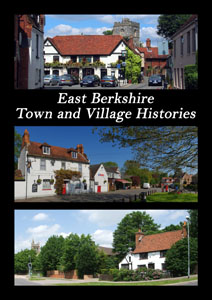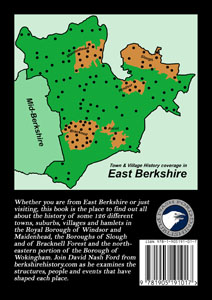RBH: History of Cookham, Berkshire (original) (raw)
Cookham
Saxon Burgh & Stanley Spencer

The Romans appear to have had some sort of settlement at the southern end of the village. This was approximately at the junction of the Roman roads known as the Camlet Way and Alderman Silver�s Road. The place may have been a villa, though the main building has not yet been discovered. Finds of quern stones and agricultural implements certainly imply a farming community, as do two impressive corn-drying facilities.
The Camlet Way ran from St Albans to Silchester and appears to have crossed the Thames at Sashes Island in Cookham. Wooden piles and stakes found there in the 19th century (and again in 1969) may indicate the remains of a substantial bridge. There was probably an adjoining river port named Cwch-ium � Celtic for Boat-Place (the alternative Anglo-Saxon Cook�s Home seems somewhat obscure). The earliest Anglo-Saxon settlers in the parish appear to have liked the area around Cookham Rise, but later they moved towards the river. The island of Odney may have been sacred to the chief Anglo-Saxon god, Woden: �Od�n-ey meaning Woden�s Isle. Nearby Sashes Island eventually became one of King Alfred�s burhs, a fortified place of refuge built for use during periods of Viking invasion.
The present village of Cookham probably mostly took off in the 8th century after an Anglo-Saxon monastery was founded there. It was probably a twin-house for both monks and nuns. A national religious synod once met there. The old abbey church is probably the basis of the present parish church which shows signs of Anglo-Saxon work in the chancel. It certainly became an Anglo-Saxon Minster in later years. The kings of Wessex also had a �Royal Vill� or intermittent palace next door, where the Witan (Anglo-Saxon parliament) met in AD 997. This probably stood in Little Berry Field.
The present church is mostly 13th century, but there is an interesting Lady Chapel closely dated to 1182. It was built on the site of a hermitage that adjoined the old Norman building. An anchoress lived there through the generosity of King Henry II, who may have been trying to expiate himself for the murder of St Thomas Becket in his name. She died in 1181 and was probably buried in the Norman style grave found just outside the walls. There were less virtuous inhabitants interred in the churchyard in later centuries. The parish register contains the following entry:
March 9th 1741, Richard Smith, a highwayman shot on the road.
There are several good brasses in the church. One is to Edward Woodyer (1613) whose home, Churchgate House, adjoins the churchyard. This old timber-framed house was originally built around 1350. It has a priest-hole and is said to have been the residence of the Abbot of Cirencester. Though this man was officially the village rector, he was probably rarely seen there. The extent of Cirencester Abbey�s property was said to be marked by the Tarry Stone (or Cookham Stone) that now stands at the end of the High Street but was originally in the middle of the road junction just opposite. This is a very mundane explanation for the presence of a fascinating object. It is an old sarsen stone, not native to the area, which may indicate some ancient religious significance, perhaps remembered in the village games that were once played around it.
Cookham is most famous as the home ofStanley Spencer who lived in the village for many years and several of his paintings � notably �The Resurrection, Cookham� � were set there. His grave can be seen in the churchyard and the village even has its own art gallery dedicated to his memory. It is housed in the old Methodist Chapel in which he once worshipped.
Kenneth Grahame wrote the �Wind in the Willows� at Cookham Dean and the character of Mr Toad was inspired by the eccentric Colonel Francis Ricardo of Lullebrook House (now the Odney Club and perhaps the original �Toad Hall�) on Odney Island. He was the Sheriff of Berkshire in 1894 and 1913 and the first person in Cookham to own a car: a canary yellow Rolls Royce Silver Ghost � just like the one that got Mr Toad into so much trouble. Grahame mentions the ford near the old fort on Sashes Island as the place where Otter taught his son, Portly, to swim.
Read more history of Cookham and other settlements in the parish in David Nash Ford's book, 'East Berkshire Town and Village Histories'. Click to Order direct from the Author.
|  |
|  | NEW BOOK Whether you are from East Berkshire or just visiting, this book is the place to find out all about the history of some 126 different towns, suburbs, villages and hamlets around Windsor and Maidenhead, Slough and Bracknell Forest. Join David Nash Ford from berkshirehistory.com as he examines the structures, people and events that have shaped each place. Some of these histories were first published in part here on this website, but they have all been considerably expanded and are joined by many new histories of places often missed by historians, including those which only joined Berkshire in 1974 or later. Click for full details and purchase options. | |
| -------------------------------------------------------------------------------------------------------------------------------------------------------------------- | ------------------------------------------------------------------------------------------------------------------------------------------------------------------ | ----------------------------------------------------------------------------------------------------------------------------------------------------------------------------------------------------------------------------------------------------------------------------------------------------------------------------------------------------------------------------------------------------------------------------------------------------------------------------------------------------------------------------------------------------------------------------------------------------------------------------------------------------------------------------------------------------------------------------------------------------------------------------------- | |
| NEW BOOK Whether you are from East Berkshire or just visiting, this book is the place to find out all about the history of some 126 different towns, suburbs, villages and hamlets around Windsor and Maidenhead, Slough and Bracknell Forest. Join David Nash Ford from berkshirehistory.com as he examines the structures, people and events that have shaped each place. Some of these histories were first published in part here on this website, but they have all been considerably expanded and are joined by many new histories of places often missed by historians, including those which only joined Berkshire in 1974 or later. Click for full details and purchase options. | |
| -------------------------------------------------------------------------------------------------------------------------------------------------------------------- | ------------------------------------------------------------------------------------------------------------------------------------------------------------------ | ----------------------------------------------------------------------------------------------------------------------------------------------------------------------------------------------------------------------------------------------------------------------------------------------------------------------------------------------------------------------------------------------------------------------------------------------------------------------------------------------------------------------------------------------------------------------------------------------------------------------------------------------------------------------------------------------------------------------------------------------------------------------------------- | |
